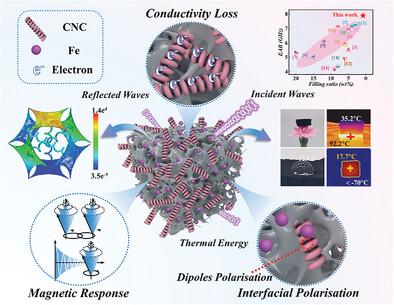Carbon Nanocoils-Assisted Formation of Tunable Pore Graphene Aerogels for Lightweight Broadband Microwave Absorption, Thermal Insulation, and Antifreeze Devices
IF 13
2区 材料科学
Q1 CHEMISTRY, MULTIDISCIPLINARY
引用次数: 0
Abstract
The rational design of the aerogel pore structure facilitates the maximum excitation of the materials physicochemical properties, which enables the modulation of their electromagnetic performance. However, the controllable adjustment of the aerogel pore structure remains a significant challenge. Here, the freeze-thawing process and thermal annealing treatment are introduced to prepare reduced graphene oxide (rGO)/iron (Fe)/carbon nanocoil (CNC) aerogels. The composite aerogels with tunable pore structure are obtained by adjusting the content of CNC. Both experiments and simulations confirm that the pore structure with the addition of CNC presents a continuous 3D conductive network, which improves the conductivity loss and polarization loss. Meanwhile, the amorphous carbon structure within the CNC causes structural defects, which further enhance the polarization loss. Therefore, the rGO/Fe/CNC aerogel with optimized pore structure has lightweight and efficient electromagnetic wave absorption. At an ultra-low filling ratio of 0.8 wt%, the effective absorption bandwidth reaches 7.9 GHz and the optimal reflection loss is −43.5 dB. In addition, due to the 3D continuous network interwoven of aerogels and the temperature stability of carbon nanomaterials, composite aerogels have excellent thermal insulation, antifreeze performance, and hydrophobicity. This multifunctional absorber has great potential for application in complex and changing electromagnetic environments.

求助全文
约1分钟内获得全文
求助全文
来源期刊

Small
工程技术-材料科学:综合
CiteScore
17.70
自引率
3.80%
发文量
1830
审稿时长
2.1 months
期刊介绍:
Small serves as an exceptional platform for both experimental and theoretical studies in fundamental and applied interdisciplinary research at the nano- and microscale. The journal offers a compelling mix of peer-reviewed Research Articles, Reviews, Perspectives, and Comments.
With a remarkable 2022 Journal Impact Factor of 13.3 (Journal Citation Reports from Clarivate Analytics, 2023), Small remains among the top multidisciplinary journals, covering a wide range of topics at the interface of materials science, chemistry, physics, engineering, medicine, and biology.
Small's readership includes biochemists, biologists, biomedical scientists, chemists, engineers, information technologists, materials scientists, physicists, and theoreticians alike.
 求助内容:
求助内容: 应助结果提醒方式:
应助结果提醒方式:


